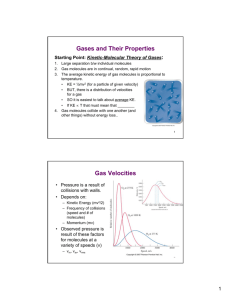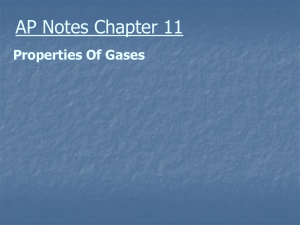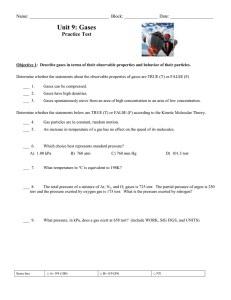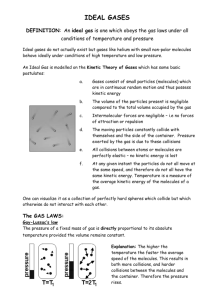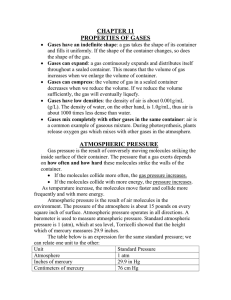Properties of Gases
advertisement
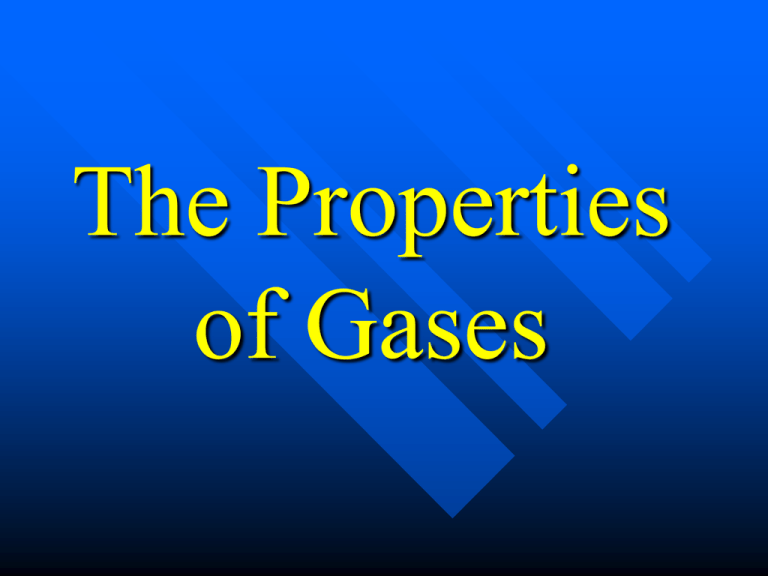
The Properties of Gases Properties of Gases Gases expand to fill the container. 2. Gases take on the shape of the container. 3. Gases are highly compressible. 1. (Can be liquefied at high pressures). Gases have low densities. 5. Gases mix uniformly. 4. The Kinetic Molecular Theory The kinetic molecular theory describes the behavior of ideal gases. An ideal gas is one that conforms to the KMT. 1. Molecules are in constant random motion Temperature is proportional to the average kinetic energy of the 2 molecules. KE = ½ mv KE = ½ mass times speed squared The speed is proportional to the absolute temperature (Kelvin). 2. A gas is mostly empty space Molecules are far apart from each other. This accounts for the low density and high compressibility. The volume of the individual molecules is negligible compared to the volume of the gas. 3. No intermolecular forces There are no attractive or repulsive forces between gas molecules. Adjacent molecules do not attract or repel each other. 4. Collisions are elastic When gas molecules collide with each other they may speed up or slow down, BUT … The net (total) energy of the gas molecules does not change. Kinetic Molecular Theory Gases in constant motion, speed depends on temperature. 2. Molecules have negligible volume. 3. No intermolecular forces. 4. Elastic collisions. No change in energy. 1. Temperature reminder When doing calculations, temperature must always be in an absolute temperature scale … … where the lowest possible temperature is zero degrees. Use Kelvin degrees! Temperature conversion K = C + 273 Pressure 1. Pressure is the force per unit area exerted by the gas molecules. 2. Pressure is proportional to the number of collisions between the gas molecules and the walls of the container. Pressure 1. Pressure is a measure of the force per unit area. force Pressure can be in P = area pounds per square inch (PSI), or … 2 … newtons per square meter (N/m ) pascal (Pa) = 2 N/m Pressure 1. Pressure is a measure of the force per unit area. force P= Glass tube with Hg area At sea level, air pressure holds up a column of mercury 760 mm high. Bowl of Hg Torricelli Pressure Measurements Standard sea level pressure is… 1.00 atmospheres (atm) 760 mm Hg 760 torr (from Torricelli) 101.3 kilopascals (kPa) 2 14.7 lb/in Pressure Measurements Standard sea level pressure is… 1.00 atmospheres (atm) 760 mm Hg 760 torr (from Torricelli) 101.3 kilopascals (kPa) 2 14.7 lb/in Pressure 2. Pressure is proportional to the number of collisions between the gas molecules and the walls of the container. If you change the number of collisions, you change the pressure. Do the following conversions: 1. 2. 3. 4. 5. Express 20.0 C in K. What is 200. K in Celsius? Convert 695 torr to atm. Convert 0.952 atm to kPa. Convert 500. kPa to atm. Now do these conversions: 1. 2. 3. 4. 5. Express -30.0 C in K. What is 576 K in Celsius? Convert 705 mm Hg to kPa. Convert 3.50 atm to torr. Convert 84.3 kPa to atm.



